2022 Porsche 911 GT3 Review: You Get What You Give


It happens not too long after I’ve picked up photographer Harry Zhou. We’re high-tailing it out of the crowded city to get to some good roads when the opportunity presents itself. I pull the PDK shifter closer for full manual control, steel myself, and watch the central tachometer do its fast-forward bit. In seconds, the flat-six goes through more personality changes than James McAvoy’s character in Split. Docile and smooth below two grand. A metallic zing at double that. At six thousand the note pitches upward, then crescendoes at an all-encompassing banshee wail straight from the pit lane at Le Mans.
For its engine alone, the GT3 should be celebrated: it’s a small miracle this rev-happy wonder even exists. But focusing on the engine ignores everything else Porsche has done to make the 2022 GT3 the most accomplished model in a 23-year string of hits. Those lucky enough to find themselves behind the wheel will get exactly as much out of the GT3 as they put into it. This is pure, distilled driving enjoyment.
What’s new?
For 2022, the GT3 now uses the 992-generation neunelfer platform that debuted two years ago. The 911 grew in all directions then, and in other trims, it feels it: still agile and quick, of course, but more of a grand tourer than ever before. Even the mega-talented Turbo S I drove earlier in the summer isn’t immune.
SEE ALSO: Making New Father’s Day Memories with a Porsche 911 TurboThe GT3 pares all that pesky compliance back. The suspension is firmer. There’s less sound-deadening material. The engine is the only one in the 911 family not breathing through a set of turbos, so there’s less of that off-idle torque to effortlessly cruise around on. Peak figures are barely changed from the last GT3: horsepower is up just 2, to 502 hp, delivered at a sky-high 8,400 rpm. Maximum torque is now 346 lb-ft (an improvement of 7 lb-ft). A six-speed manual is standard, while the optional PDK transmission is a seven-speed unit unique from the eight-speed other 911s use. All-wheel drive? Pffft, easy mode. The GT3 remains two-wheel-drive only, not corrupting the front wheels with the simultaneous tasks of power delivery and steering.
FAST FACTS
| Engine: | 4.0L F6 |
| Output: | 502 hp, 346 lb-ft |
| Transmission: | 7DCT, RWD |
| US fuel economy (MPG): | 15/20/17 (est) |
| CAN fuel economy (L/100KM): | 15.7/11.8/13.8 (est) |
| Starting Price (USD): | $162,450 (inc. dest.) |
| As-Tested Price (USD): | $198,000 (inc. dest.) |
| Starting Price (CAD): | $181,800 (inc. dest.) |
| As-Tested Price (CAD): | $222,340 (inc. dest.) |

Those front wheels—20-inch center-lock dealies, wrapped in wider, 255-series Michelins—now hook up to a double-wishbone suspension, a first for a road-going 911. Like so many other parts of the GT3, the suspension is race-proven, essentially the same setup as the mid-engined 911 RSR race car. The front track is now nearly two inches (50 mm) wider than the regular Carrera’s, as well. Add it all up and the GT3 should turn in and maintain grip better than the 2019 model, which was far from a slouch to begin with.
There’s a dramatic, race-inspired change to the GT3 exterior, too. It’s impossible to ignore that enormous, adjustable swan-neck rear wing, but it brings with it significant improvements. Leave it at its standard angle of attack and there’s 50-percent more downforce than the 991.2 GT3. Pop it into its more aggressive setting and you’re looking at 150 percent. Of course, you’ll need a track to properly explore the speeds necessary to real feel that invisible hand push the GT3 into the ground.
The rest of the package is pretty standard 992, with a new twin-nostril hood, larger diffuser, and a pitch-perfect stance over the staggered-sized wheels. Shark Blue is a pricey option, especially with the accompanying pinstriping in the headlights and on the wheels, but it’s a stunner.
How does it drive?

It takes about 50 feet before the GT3 feels unique. The first turn of the wheel is all that’s needed: any amount of slack found in a 992 Carrera, no matter how minute, is exorcised here. The 911 has one of the very best steering wheels, with the right size and thickness. This Alcantara-wrapped one is even more communicative, full of feel and feedback. There’s a good amount of weight to it too, providing the confidence to really lean on that new double-wishbone front end. Of course there’s tons of grip there, but there’s also an added level of stability. Turn-in is strong enough to pull phones out of passenger hands, and so quick I swear the steering is hooked right to my synapses. No matter how many of those 502 horses are testing the huge 315-section rear tires, the nose stays pointed exactly where I want.
SEE ALSO: Chevrolet Corvette vs Porsche 718 Boxster vs Toyota Supra: Sports Car ShootoutThe suspension is firm, but only because it views things like pitch and roll with the same level of disdain as a bodybuilder does a sundae. The GT3 hoovers up bumps and mid-corner ridges while staying resolutely planted on the desired line.

Contributing to the car’s agility is a light curb weight of just 3,164 pounds (1,435 kg). That’s barely more than the last GT3, despite the increased dimensions. Porsche has used carbon fiber reinforced plastic in more places, including the wing, ducktail spoiler, and hood—the latter being hilariously light to open for cargo duty. The glass is thinner, and the rear seats are now gone. If weight is the enemy, you can defeat it even more thoroughly by speccing the carbon roof, or the carbon-ceramic brakes found on this German-spec tester.
These enormous discs are tireless on the road. The left pedal is wonderfully progressive, and it’s shocking how late the GT3 can brake into corners and still scrub the necessary speed.

And that engine. Forget the peaky-seeming headline figures: the 4.0-liter is tractable from any part of the rev range. Throttle response is Wüsthof-sharp, and the long-travel pedal works as its own sort of traction control, meting out each individual horsepower. Bury it and the GT3 is amongst the very quickest cars on the road, shoving you into the seat as it catapults forward, all without a hint of nose lift.
The PDK hooked up to the 4.0-liter is unique to the GT3. It’s a much more mechanical experience than the regular eight-speed, not least because it swaps out the tiny Gillette of a shifter for a more traditional stalk. Effort is required to move the shifter fore and aft, with a hefty, satisfying motion. From a standstill, the PDK operates more like a traditional manual too, requiring a tickle of the throttle to get moving. The GT3 will roll backwards on any sort of incline, too. Leave it in full-auto mode and the GT3’s gearbox is preturnaturally gifted at knowing exactly which gear it needs to be in for the task at hand. It’d be spooky if I didn’t have such a big grin on my face.
SEE ALSO: 5 Ways the 2020 BMW M2 CS Marks the Glorious End of an EraCalming down for city duty

As the GT3 has become an ever more accomplished track weapon, the question has always been whether it’s too compromised for street duty. The answer is no—mostly.
The optional bucket seats are a mixed blessing. They look the business, and once I’m installed in the driver’s seat, I’m comfortable no matter the trip length. I’m not exactly a big guy though, and even still, the tight seats had me questioning whether I really wanted that extra slice of pizza. And forget any semblance of grace as you clamber in and out, with the high side bolsters making it all but impossible.
The rest of the interior is the same inherent goodness found across the 992 range, however. The 911 is an easy car to see out of, with a low cowl and thin pillars. Naturally, the rearview mirror is less useful, with the big wing taking up most of the view. Instrumentation includes the classic central tachometer, with two digital sections on either side mimicking the traditional five-cluster design. The central touchscreen is a 10.9-inch affair, with wireless CarPlay but zero Android Auto support.
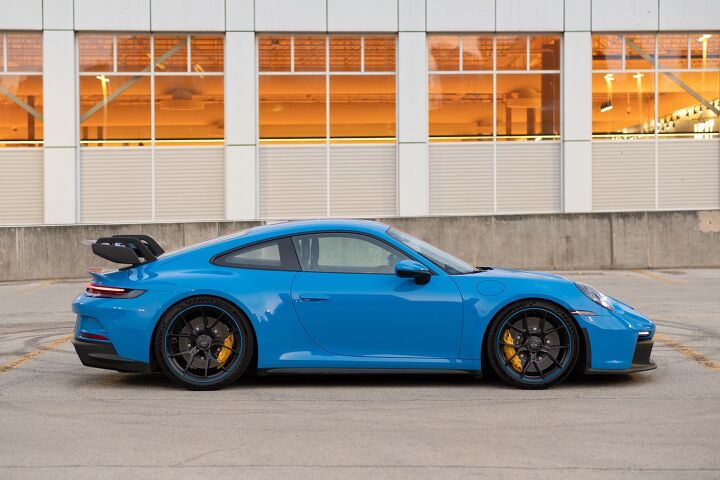
During my short time with the GT3, in addition to the city escape, I put it to work doing a grocery run, and dropping my fiancée off at the train station. The former was easy-peasy, with everything fitting either in the nose or on the shelf where the rear seats used to be. The front swallowed a rolly-bag pretty easily too, though you do get some puzzled looks at Union Station that early in the day in something shaped like the GT3.
In its softest setting, the GT3’s suspension is still firm, if livable. The sheer volume of construction in the city core did have me pre-emptively wincing at multiple points, but the 911 handles it well. There is a lot of noise from the suspension doing its thing, however, as well as the pinging of any stones the sticky tires fling at the wheel wells.
What’s the competition?

Honestly? Nothing. There’s no other car as single-mindedly focused as the GT3 under $200,000, at least not for road use. The Lamborghini Huracan STO and Mercedes-AMG GT Black Series are closest in spirit, but both start at roughly double the GT3’s $162,450 ($181,800 CAD) destination-included starting price.
In this rarified air, would-be buyers could trade the GT3’s race-car-for-the-road vibe for the softer, more everyday-ready vibe of something like an Audi R8. Maybe you want a bit of electrification in your supercar: Acura will still sell you an NSX in 2022, in hotter Type S form no less. There’s even competition from within the 911 range: the Turbo starts at $175,650 ($199,900 CAD). I wouldn’t begrudge anybody going for the Turbo, or the new Targa GTS for that matter; the GT3 experience isn’t for everyone.
This tester didn’t check every box on the options list, but you’re still looking at a $198,000 ($222,340 CAD) vehicle. The big options include the wicked cool Shark Blue ($4,220 / $4,820 CAD), full bucket seats ($5,900 / $6,740 CAD), black-painted wheels with pinstripes ($1,950 / $2,220 CAD), ceramic brakes ($9,210 / $10,510 CAD), and front axle-lift system ($4,180 CAD). I’d call the latter mandatory, but the rest are very much a matter of preference. The larger, 23.7-gallon (90-liter) fuel tank ($230 / $260 CAD) does stretch out the distance between fill-ups, too. Observed fuel economy was around 16.5 mpg (14.2 L/100 km) across 185 miles (300 km).
SEE ALSO: 2020 Porsche 718 Spyder Review: …and Nothing Else MattersVerdict: 2022 Porsche 911 GT3 Review

The 2022 Porsche 911 GT3 is not a complicated car. It strips away any superfluous niceties that aren’t directly related to the business of going fast. Even with an electro-mechanical steering rack, rear-wheel steering, advanced launch control, and that instant-action PDK transmission, it feels refreshingly analog in an increasingly digital world.
There’s a more serious undercurrent absent from other 911s, though. While the GT3 is reasonably happy to tootle around in city centers, that new front suspension has such vice-like control and pinpoint precision, it practically begs you to take it somewhere better suited to its talents. Oblige it, and the GT3 rewards your efforts in equal measure, providing the sort of pure, visceral driving experience that stays forever lodged in your brain’s happy memory folder.
Become an AutoGuide insider. Get the latest from the automotive world first by subscribing to our newsletter here.
LOVE IT
- Masterpiece of an engine
- So much grip, still communicative
- Conceivably daily-drivable
LEAVE IT
- Spartan interior
- Bucket seats require yoga levels of dexterity
- Doesn't currently occupy my garage

Kyle began his automotive obsession before he even started school, courtesy of a remote control Porsche and various LEGO sets. He later studied advertising and graphic design at Humber College, which led him to writing about cars (both real and digital). He is now a proud member of the Automobile Journalists Association of Canada (AJAC), where he was the Journalist of the Year runner-up for 2021.
More by Kyle Patrick







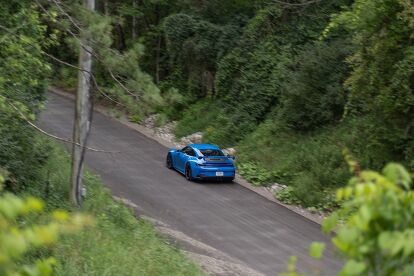






























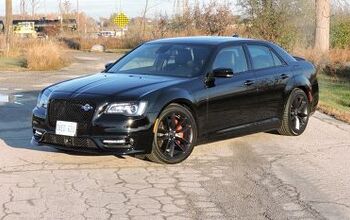
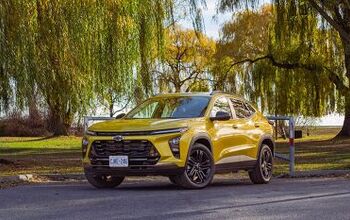


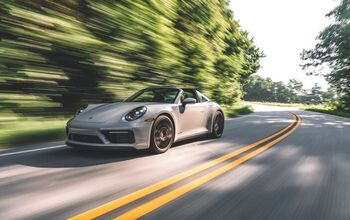












Comments
Join the conversation